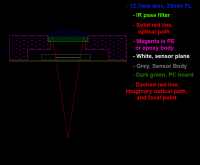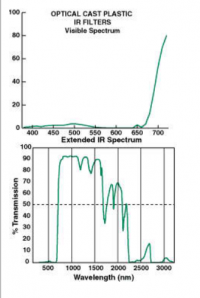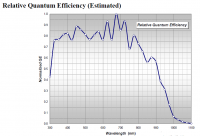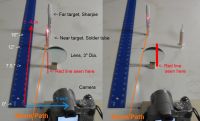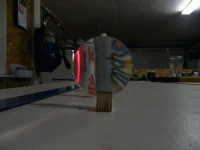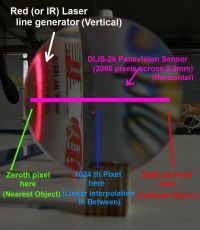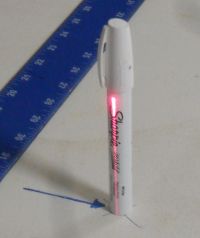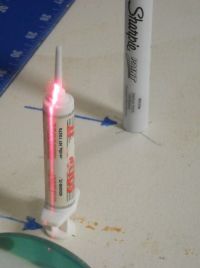
Structured Light Experiments (LiDAR Attempt).
Patrick, Wed Nov 21 2012, 09:26PMI must have already lost my mind, for even considering this project.
Purpose and Goal:
To build the most capabable LiDAR possible for 50-150 US$.
As I have found the existing solutions absolutely apalling. 400 dollars to buy and dissasemble a Neato vacuum just to get a primative lidar, or spend from 1200 to 6500 US$ for a slow phase differentiating Hykouo lidar, or perhaps 20,000 US$ on a real true time-of-flight lidar.
The need for and lack of a useful lidar for hobby and professional use has now become an intolerable obstacle, if no one else can or will resolve this matter, then i guess ill have too. The problem of robot control and manuevering within human occupied or natural enviroments can only be solved through the use of LiDAR and SLAM. Therefore, without good data (from a LiDAR) it doesnt matter how good your SLAM implementation is. Thus the unavoidable need for cheap, plentiful, and capable LiDAR for robotic fleets of all types (civil and martial).
Solution:
The use of structured light, as demonstranted by the XV-11 lidar in the Neato robotic vacuum. Im hoping for assistance from SparkFun and Parrallax companies and similar minded groups and individuals. I intend for the end device to be open source as much as possible ...
Connection:
im thinking of using SPI for the conection method. So the connection will work as follows :
(Lidar with internal STM32 MCU w/SPI) --> SPI --> (End-User Embedded MCU w/SPI)
Im thinking this will be easier and faster than a crap RS-232 serial TTL 115kbps connection like inb the XV-11.
Previous Threads and Research:
Previous Threads:<- SLAM for Dummies Like Me!!!
<- Does anyone know how these LiDARs work?
<- CSU Chico Tilt Rotor Flying Machine, (Programming and CPU, 3 of 3).
Links and Research:
Initial Idea:
Specs for Final Device:
Range: 1 foot min, 45 feet max.
Resolution: about 1 inch
Wavelength: NIR or IR, (700nm -1000nm) [Visible (red) for initial calibration only.]
Viewable arc: 360 degrees (i hope)
Enviromental: above freezing, below 150 degree F (*Earth use only), eye safe (i hope) significant unwanted light between 700nm and 1000nm may be a problem.
Size: 4 inch cube
Power: 5v at 300-500mA
Components:
Filter: IR filter passes 700nm and longer, will suppress all visible and UV light.
Main Lens: 12mm diameter, 33mm FL, uncoated, glass.
Main Mirror: TBD, probably a tiny normal mirror cut on a tile saw.
Motor: Probably a DVD/CD motor, about 1200-3000rpm.
Laser: IR 780nm or IR 808nm, laser line, 60 degrees cut down to 20 deg by blinders. 5 and 20mW. (The line will be vertical.)
MCU:Probably STM32 F1.
Detecting Element: Panavision DLIS-2k or DLIS-4k linear pixel senor (monochromatic) [the DLIS-4k is no longer made.]
Cost:
Lasers: 11 and 14 US$
Lens: 4 to 9 US$
filter: 2 US$ (once cut to size)
Mirror: 1 US$ (estimated)
Detector: Unkown
Motor: 2-5 US$ (estimated)
MCU, and PCB: 10 US$ or less
Screws, Case, Wire and Plastic: Aproxiamtley 10 US$\
(I'm trying to keep the build cost to about 50 US$)
Data Sheets and Application Notes:
]app0002_rev_d_appnote.pdf[/file] Panavision DLIS sensor family App Note.
]pds0038revg_datasheet.pdf[/file]Panavision DLIS family Data Sheet. (DLIS-2k)
Technical Points:
A Specific Note On The Filter And Detector:
The filter that i found will pass 700nm and longer, but will block all visible and UV light. The panavision DLIS family is sensitive to a suprisingling limited amount of the IR spectrum. It has been optimised for the detection of viisble light, red specifically, for bar code and fingerprint type machine vision applications. it is insensitive to longer than 1000nm light. Therfore all light that will reach the DLIS senor will be longer than 700nm and shorter than 1000nm, a narrow 300nm passband! i am hoping this will lead to a high signal and low noise condition at the sensor plane.
And for the Lasing Physics:
Within the narrow 300nm passband there will be two possible laser light beams. either a 780nm, 5mw, NIR laser diode module, or a 808nm, 20mW, IR. Both will be line generating lasers. This line will be vertical to the sensor plane, which is horizontal. This arrangement ensures alignment and a narrow but definante fall pattern on the sensor, even with age, vibration and temperature creep.
Supporting graphs for sensor and filter:
Filter, frequency/transmitivity graph.
Frequency sensitivity of Sensor, Panavision DLIS family.
Frome the above graphs we see, the filter will pass 85% of the IR at near 800nm, the DLIS sensor is sensitive to 80% at 780nm and 75% at 808nm compared to red being 100% .
Sat Nov 24 2012, 06:41PM - 1:55AM
First Structured Light Experiments ! (Proof of concept / Technology demonstrator)
(Version 1, Type 1, Mod 10, Gen A) [Success!]
The Setup-up... (A poor college students optical test bench, a plywood table painted white.)
Seen in the above pic, a 12" (y-axis near) target and a 16" (y-axis, Far) Target. Which cuased a visible change of 1.4 inches in the x-axis. The camera was static for the above to pictures, however the Auto Focus did jitter a bit. Still a valid test.
Animated .gif file! Click Me!
Electro-Optical and physical configuration of the would-be sensor.
Far target, a Sharpie paint marker.
Near target, a tube of silver solder.
Lesson learned:
As expected, the width of the laser line as it falls on the DLIS sensor will deteremin the possible vs. actual resolution, as each pixel is
only 4 micrometers wide... (if the laser lights up several pixels, that reduces resolution.)
EDIT: its 1:40am and im drunk, so i might be \wrong, but CAD is indicating i can get the laser width down to 12um at the sensor plane, so that means 3 or 4 pixels will be lit buy my 2mm wide line laser beam... thus about 1 inch of resolution should be possible.
Re: Structured Light Experiments (LiDAR Attempt).
Josh Campbell, Wed Nov 21 2012, 09:31PM
Very cool. Do you have a starting point and any other details or specs.
Josh Campbell, Wed Nov 21 2012, 09:31PM
Very cool. Do you have a starting point and any other details or specs.
Re: Structured Light Experiments (LiDAR Attempt).
Patrick, Wed Nov 21 2012, 10:26PM
Patrick, Wed Nov 21 2012, 10:26PM
2bytes wrote ...
Very cool. Do you have a starting point and any other details or specs.
yes a whole bunch, but im late for Calculus 3B ATM.Very cool. Do you have a starting point and any other details or specs.
Re: Structured Light Experiments (LiDAR Attempt).
Shrad, Thu Nov 22 2012, 07:40AM
to be eye-safe you have to be around 2000nm or more, if I recall
I would try to source a pulsed laser diode (like those in the same form factor as LEDs) as you can pulse train them and they are cheaper , but I don't know if they exist in this wavelength range
closest affordable model in CW is this one
Shrad, Thu Nov 22 2012, 07:40AM
to be eye-safe you have to be around 2000nm or more, if I recall
I would try to source a pulsed laser diode (like those in the same form factor as LEDs) as you can pulse train them and they are cheaper , but I don't know if they exist in this wavelength range
closest affordable model in CW is this one

Re: Structured Light Experiments (LiDAR Attempt).
Pinky's Brain, Thu Nov 22 2012, 12:21PM
IANALE ... but I think with the lenticular/rod lens (to make a line) it's going to be eye safe unless you put your eye right in front or use a loupe.
PS. you can get IR lasers for 10s of bucks on ebay ... upto multi-watt engraving lasers. Even if you want a semi-reputable store something like Roithner is a better one to go looking for bargains (1310nm diodes are cheap, because they are mass produced for fiber communication).
Pinky's Brain, Thu Nov 22 2012, 12:21PM
IANALE ... but I think with the lenticular/rod lens (to make a line) it's going to be eye safe unless you put your eye right in front or use a loupe.
PS. you can get IR lasers for 10s of bucks on ebay ... upto multi-watt engraving lasers. Even if you want a semi-reputable store something like Roithner is a better one to go looking for bargains (1310nm diodes are cheap, because they are mass produced for fiber communication).
Re: Structured Light Experiments (LiDAR Attempt).
Patrick, Thu Nov 22 2012, 04:45PM
Patrick, Thu Nov 22 2012, 04:45PM
Pinky's Brain wrote ...
IANALE
dont know what this means.IANALE
Pinky's Brain wrote ...
... but I think with the lenticular/rod lens (to make a line) it's going to be eye safe unless you put your eye right in front or use a loupe.
I was hoping so, it will be pretty diffuse by the time a human gets in its way.... but I think with the lenticular/rod lens (to make a line) it's going to be eye safe unless you put your eye right in front or use a loupe.
Pinky's Brain wrote ...
PS. you can get IR lasers for 10s of bucks on ebay ... upto multi-watt engraving lasers. Even if you want a semi-reputable store something like Roithner is a better one to go looking for bargains (1310nm diodes are cheap, because they are mass produced for fiber communication).
the sensor wont detect longer than 1000nm IR...PS. you can get IR lasers for 10s of bucks on ebay ... upto multi-watt engraving lasers. Even if you want a semi-reputable store something like Roithner is a better one to go looking for bargains (1310nm diodes are cheap, because they are mass produced for fiber communication).
Re: Structured Light Experiments (LiDAR Attempt).
Pinky's Brain, Thu Nov 22 2012, 11:11PM
I Am Not A Laser Engineer/Expert ...
There are a lot of cheap laser diodes both at Roithner and Ebay between 800 and 1000 as well.
BTW, pulsed lighting is rather interesting since the sensor can have very short sampling times ... it will reduce the impact of motion and decreases the average power.
Pinky's Brain, Thu Nov 22 2012, 11:11PM
I Am Not A Laser Engineer/Expert ...
There are a lot of cheap laser diodes both at Roithner and Ebay between 800 and 1000 as well.
BTW, pulsed lighting is rather interesting since the sensor can have very short sampling times ... it will reduce the impact of motion and decreases the average power.
Re: Structured Light Experiments (LiDAR Attempt).
Patrick, Fri Nov 23 2012, 03:41AM
Patrick, Fri Nov 23 2012, 03:41AM
Pinky's Brain wrote ...
BTW, pulsed lighting is rather interesting since the sensor can have very short sampling times ... it will reduce the impact of motion and decreases the average power.
yes i realized this and plan to strobe the transmit and recieve at each needed inveral...BTW, pulsed lighting is rather interesting since the sensor can have very short sampling times ... it will reduce the impact of motion and decreases the average power.
Re: Structured Light Experiments (LiDAR Attempt).
Shrad, Fri Nov 23 2012, 12:10PM
there are risks, and it's controlled by the CDRH
your device would be considered as a laser scanning device and there is a MPE (max permissible exposure) and other fail-safe concerns
read this carefully :
and get other resources from their website about security
IR starts being eye-safe around 1500~2000nm as it's being absorbed by the eye surface rather than the retina (transparency of the eye cristaline)
Shrad, Fri Nov 23 2012, 12:10PM
there are risks, and it's controlled by the CDRH
your device would be considered as a laser scanning device and there is a MPE (max permissible exposure) and other fail-safe concerns
read this carefully :

and get other resources from their website about security
IR starts being eye-safe around 1500~2000nm as it's being absorbed by the eye surface rather than the retina (transparency of the eye cristaline)
Re: Structured Light Experiments (LiDAR Attempt).
Patrick, Sun Nov 25 2012, 02:41AM
Data sheets and app notes added to top thread...
look! -- commented pics!
Patrick, Sun Nov 25 2012, 02:41AM
Data sheets and app notes added to top thread...
look! -- commented pics!
Re: Structured Light Experiments (LiDAR Attempt).
Patrick, Sun Nov 25 2012, 09:08AM
you saved me with this Roithner link!! TY!!
EDIT: its 1:40am and im drunk, so i might be \wrong, but CAD is indicating i can get the laser width down to 12um at the sensor plane, so that means 3 or 4 pixels will be lit buy my 2mm wide line laser beam... thus about 1 inch of resolution should be possible.
Patrick, Sun Nov 25 2012, 09:08AM
Pinky's Brain wrote ...
There are a lot of cheap laser diodes both at Roithner and Ebay between 800 and 1000 as well.
There are a lot of cheap laser diodes both at Roithner and Ebay between 800 and 1000 as well.
you saved me with this Roithner link!! TY!!
EDIT: its 1:40am and im drunk, so i might be \wrong, but CAD is indicating i can get the laser width down to 12um at the sensor plane, so that means 3 or 4 pixels will be lit buy my 2mm wide line laser beam... thus about 1 inch of resolution should be possible.
Re: Structured Light Experiments (LiDAR Attempt).
Patrick, Sun Nov 25 2012, 07:36PM
Added a animated .gif, will soon upload -- experiment 2 (long range, dark object and thin pixel lighting.)
First major problem, i dont know how to calculate the width of the laser light as it falls on the pixel array. At 2.9 meters distance, the laser is 1.9mm wide, but once it strikes an object and returns to the lens, how do i calculate its width? the pixels are 4um wide, and im hoping for about 8-12um beam width on the sensor.
Patrick, Sun Nov 25 2012, 07:36PM
Added a animated .gif, will soon upload -- experiment 2 (long range, dark object and thin pixel lighting.)
First major problem, i dont know how to calculate the width of the laser light as it falls on the pixel array. At 2.9 meters distance, the laser is 1.9mm wide, but once it strikes an object and returns to the lens, how do i calculate its width? the pixels are 4um wide, and im hoping for about 8-12um beam width on the sensor.
Re: Structured Light Experiments (LiDAR Attempt).
Steve Conner, Mon Nov 26 2012, 01:05PM
Care to explain what "structured light" means in this context and how your experiments indicate success?
Steve Conner, Mon Nov 26 2012, 01:05PM
Care to explain what "structured light" means in this context and how your experiments indicate success?
Re: Structured Light Experiments (LiDAR Attempt).
Patrick, Mon Nov 26 2012, 10:12PM
Now i need to demonstrate that 4um pixels can be lit up, with a 10-14um beam...
Patrick, Mon Nov 26 2012, 10:12PM
Steve Conner wrote ...
Care to explain what "structured light" means in this context and how your experiments indicate success?
i measured a 4 inch y-distance, with a 1.4 x-distance, thus prooving a long triangle can measure a long distance with a short side/ angle change.Care to explain what "structured light" means in this context and how your experiments indicate success?
Now i need to demonstrate that 4um pixels can be lit up, with a 10-14um beam...
Re: Structured Light Experiments (LiDAR Attempt).
Patrick, Mon Dec 10 2012, 02:25AM
ok with the help from forum users here, ive been able to get enough math and mechanics, optics, and such to make a first attempt soon.
This first effort/device will be called : "prototype 1-A" (visible light tests)
then, "1-B, a full IR and pixel array, with no rotation.
After i learn enough, and if successfull ill move on to rotating in version "1-C"
pics to follow shortly...
Patrick, Mon Dec 10 2012, 02:25AM
ok with the help from forum users here, ive been able to get enough math and mechanics, optics, and such to make a first attempt soon.
This first effort/device will be called : "prototype 1-A" (visible light tests)
then, "1-B, a full IR and pixel array, with no rotation.
After i learn enough, and if successfull ill move on to rotating in version "1-C"
pics to follow shortly...
Re: Structured Light Experiments (LiDAR Attempt).
iliasam, Mon Dec 10 2012, 06:54PM
I am also trying to create triangulation based lidar.
The work principle of my lidar is the same like in Neato.
If somebody is interested, here some information about it: http://roboforum.ru/forum10/topic12095.html (in Russian)
As you can see, my lidar is already working, but it's resolution became low in big distances (> 3m). It's caused by low resolution of image sensor (TSL1401 - it's resolution 128 pixels).
So the question - where is it possible to buy image sensor with bigger resolution?
You wrote about DLIS-2k, but I can't find, where to get it (especially in small quantity).
iliasam, Mon Dec 10 2012, 06:54PM
I am also trying to create triangulation based lidar.
The work principle of my lidar is the same like in Neato.
If somebody is interested, here some information about it: http://roboforum.ru/forum10/topic12095.html (in Russian)
As you can see, my lidar is already working, but it's resolution became low in big distances (> 3m). It's caused by low resolution of image sensor (TSL1401 - it's resolution 128 pixels).
So the question - where is it possible to buy image sensor with bigger resolution?
You wrote about DLIS-2k, but I can't find, where to get it (especially in small quantity).
Re: Structured Light Experiments (LiDAR Attempt).
Patrick, Mon Dec 10 2012, 08:38PM
Very cool work !!!
iliasam, ive PM'ed you with some details.
I would like to work with others on this matter, if possible.
Next, how did you find out about my work?
and finally, your work is cool, it appears you have considered how we are to get a SLAM model working. should we use desktop/laptops, or embedded systems?
I see even with only 128 pixels, your still getting good data. youll have to see my thread here : (there are two pages)
(there are two pages)
which documents the "range problem" and yes more pixels with a smaller pitch helps...
A few questions if you dont mind:
-how did you align your optics?
-are you using a line or dot laser? (one of your pics in the dark shows dots)
-are you using the STM32 MCU ?
-whats your RPM on your belt driven turning table ?
-How are you getting the data to the base robot? I plan to use IR .
-which pixel sensor are you using?
-what wavelength of light?
that tricylce bot is cool too!
Patrick, Mon Dec 10 2012, 08:38PM
Very cool work !!!
iliasam, ive PM'ed you with some details.
I would like to work with others on this matter, if possible.
Next, how did you find out about my work?
and finally, your work is cool, it appears you have considered how we are to get a SLAM model working. should we use desktop/laptops, or embedded systems?
I see even with only 128 pixels, your still getting good data. youll have to see my thread here :
 (there are two pages)
(there are two pages)which documents the "range problem" and yes more pixels with a smaller pitch helps...
A few questions if you dont mind:
-how did you align your optics?
-are you using a line or dot laser? (one of your pics in the dark shows dots)
-are you using the STM32 MCU ?
-whats your RPM on your belt driven turning table ?
-How are you getting the data to the base robot? I plan to use IR .
-which pixel sensor are you using?
-what wavelength of light?
that tricylce bot is cool too!
Re: Structured Light Experiments (LiDAR Attempt).
iliasam, Tue Dec 11 2012, 10:21AM
But I can't normally start SLAM node - the resulting map was very bad (I think that it's caused by low lidar speed).
For DLIS-2K would be good STM32F4 controller, because it's has DCMI interface. GPIO is too slow for such data frequencies.
Laser is modulated with short pulses, so average power of laser is 7 mw.
I'm know that my laser is not safe for eyes.
Using image sensor with better sensitivity allow to decrease laser power.
Bot is Roomba 400. It's controlled from PC by me manually.
iliasam, Tue Dec 11 2012, 10:21AM
how did you find out about my work?It's interesting, but I think that if you try to use line for scanning, image sensor wouldn't get enough light.
it appears you have considered how we are to get a SLAM model workingI have connected my lidar to ROS (running at PC): http://roboforum.ru/forum10/topic12095-60.html#p253548
But I can't normally start SLAM node - the resulting map was very bad (I think that it's caused by low lidar speed).
-how did you align your optics?As you can see on photos, laser has a simple holder, which allow to change beam direction by rotating two screws. Also, laser holder can be rotated to the left/right.
-are you using a line or dot laser? (one of your pics in the dark shows dots)Yes, it's simple dot laser.
-are you using the STM32 MCU ?Yes, the controller is STM32F100C4. It's enough for 128 pixels senor, but for bigger resolution sensor more powerful controller would be necessary.
For DLIS-2K would be good STM32F4 controller, because it's has DCMI interface. GPIO is too slow for such data frequencies.
-whats your RPM on your belt driven turning table ?It's slow - 3 rotation per second.
How are you getting the data to the base robot? I plan to use IR .Now I'm using bluetooth module, but I'm thinking about slip ring (like in Neato).
-which pixel sensor are you using?TSL1401
-what wavelength of light?I'm using red laser from DVD drive, because usual 3 mw laser module doesn't give enough light. I cant measure power of my laser, but I think it's 20 mw (without modulation).
Laser is modulated with short pulses, so average power of laser is 7 mw.
I'm know that my laser is not safe for eyes.
Using image sensor with better sensitivity allow to decrease laser power.
Bot is Roomba 400. It's controlled from PC by me manually.
Re: Structured Light Experiments (LiDAR Attempt).
Patrick, Tue Dec 11 2012, 06:08PM
the STM32F4 is fast, i have one, but i dont think we will run into speed problems with the STM32 and DLIS-2k, the DCMI is really meant for full cameras... i would have thought the GPIO's would be fast enough... 10MHz transistion times on parrallel GPIO pins should be doable.
Patrick, Tue Dec 11 2012, 06:08PM
the STM32F4 is fast, i have one, but i dont think we will run into speed problems with the STM32 and DLIS-2k, the DCMI is really meant for full cameras... i would have thought the GPIO's would be fast enough... 10MHz transistion times on parrallel GPIO pins should be doable.
Re: Structured Light Experiments (LiDAR Attempt).
iliasam, Tue Dec 11 2012, 08:04PM
With the lidar speed - 10 rps and laser modulation, data frequency would be:
360*10*2*2097=15 MHz.
Also there is another problem - DLIS-2k pixels a very small, so micron misalignment would case distance calculation error, so laser and image sensor holders must really solid and strong.
In my lidar I have found that the small pressure to one side of the lidar case error, and my sensor is only 128 pixel wide.
So now I am thinking about making lidar with stronger mechanics, and ELIS-1024 sensor.
ELIS-1024 can be switched to 128 pixels resolution, so the changes in microcontroller program will be small.
iliasam, Tue Dec 11 2012, 08:04PM
With the lidar speed - 10 rps and laser modulation, data frequency would be:
360*10*2*2097=15 MHz.
Also there is another problem - DLIS-2k pixels a very small, so micron misalignment would case distance calculation error, so laser and image sensor holders must really solid and strong.
In my lidar I have found that the small pressure to one side of the lidar case error, and my sensor is only 128 pixel wide.
So now I am thinking about making lidar with stronger mechanics, and ELIS-1024 sensor.
ELIS-1024 can be switched to 128 pixels resolution, so the changes in microcontroller program will be small.
Re: Structured Light Experiments (LiDAR Attempt).
Patrick, Tue Dec 11 2012, 10:30PM
Patrick, Tue Dec 11 2012, 10:30PM
iliasam wrote ...
Also there is another problem - DLIS-2k pixels a very small, so micron disalignment would case distance calculation error, so laser and image sensor holders must really solid and strong.
thats why i and the XV-11 use a vertical line generator, which light up the 4x32um pixels.Also there is another problem - DLIS-2k pixels a very small, so micron disalignment would case distance calculation error, so laser and image sensor holders must really solid and strong.
iliasam wrote ...
In my lidar I have found that the small pressure to one side of the lidar case error, and my sensor is only 128 pixel wide.
So now I am thinking about making lidar with stronger mechanics, and ELIS-1024 sensor.
ELIS-1024 can be switched to 128 pixels resolution, so the changes in microcontroller program will be small.
yes it must be ridgid. but with coarse pixels, youl loose range data... also my plan is to count dark pixels form close to far, then count lit pixels and divide by 2 then adding the dark pixel count. that would be one distance point.In my lidar I have found that the small pressure to one side of the lidar case error, and my sensor is only 128 pixel wide.
So now I am thinking about making lidar with stronger mechanics, and ELIS-1024 sensor.
ELIS-1024 can be switched to 128 pixels resolution, so the changes in microcontroller program will be small.
Re: Structured Light Experiments (LiDAR Attempt).
Patrick, Wed Dec 12 2012, 05:28AM
New Work !
first visible light test arragement with red laser line generator.
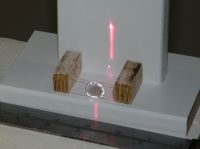
12.7mm dia lens, with FL of 33mm. red laser light and its epoxied to a 1.5mm acrylic plate.
(the final version for IR will be epoxied to the 1.5mm thick filter.)
I shot the laser light in directly, so im not sure the beam width is accurate. beam length for the above test is 134 inches long, and in the pic its 0.140 wide...[thus 3.56mm wide @ 3.4m] and the thin beam is 0.033 " (or 0.8mm) wide.
EDIT: the O'great CAD gods are telling me that at 2.9m a 1.5mm beam will be 18um wide at the sensor plane, which is about 4 pixels wide.
Patrick, Wed Dec 12 2012, 05:28AM
New Work !
first visible light test arragement with red laser line generator.

12.7mm dia lens, with FL of 33mm. red laser light and its epoxied to a 1.5mm acrylic plate.
(the final version for IR will be epoxied to the 1.5mm thick filter.)
I shot the laser light in directly, so im not sure the beam width is accurate. beam length for the above test is 134 inches long, and in the pic its 0.140 wide...[thus 3.56mm wide @ 3.4m] and the thin beam is 0.033 " (or 0.8mm) wide.
EDIT: the O'great CAD gods are telling me that at 2.9m a 1.5mm beam will be 18um wide at the sensor plane, which is about 4 pixels wide.
Re: Structured Light Experiments (LiDAR Attempt).
iliasam, Wed Dec 12 2012, 08:55AM
iliasam, Wed Dec 12 2012, 08:55AM
thats why i and the XV-11 use a vertical line generator, which light up the 4x32um pixels.I wrote about horizontal misalignment, it does not depend on laser beam form.
Re: Structured Light Experiments (LiDAR Attempt).
Patrick, Wed Dec 12 2012, 09:00AM
Iliasam, you should try with the ELS-1024, and ill try the DLIS-2k, that way well have good use of our efforts. then well evaluate the results and lessons learned. also want mine to be eye-safe.
Patrick, Wed Dec 12 2012, 09:00AM
iliasam wrote ...
ok, i think for horizontal alignment, we just need the laser and detector to be ultra-stiff. and strong.thats why i and the XV-11 use a vertical line generator, which light up the 4x32um pixels.I wrote about horizontal misalignment, it does not depend on laser beam form.
Iliasam, you should try with the ELS-1024, and ill try the DLIS-2k, that way well have good use of our efforts. then well evaluate the results and lessons learned. also want mine to be eye-safe.
edit: im thinking of using one of these RF 433MHz radios for the transmission of data.
Re: Structured Light Experiments (LiDAR Attempt).
Shrad, Mon Dec 17 2012, 01:52PM
Patrick,
While searchink for laser diode driver papers I stumbled upon this :
I think it is really close to what you are attempting and contacting them would raise a flag on several issues you could face, so more energy is spent polishing the design instead of bumping on obstacles
Shrad, Mon Dec 17 2012, 01:52PM
Patrick,
While searchink for laser diode driver papers I stumbled upon this :

I think it is really close to what you are attempting and contacting them would raise a flag on several issues you could face, so more energy is spent polishing the design instead of bumping on obstacles
Re: Structured Light Experiments (LiDAR Attempt).
Patrick, Mon Jan 14 2013, 01:32AM
ok new work completed...
ive got two line generating lasers, one will be kep as a backup, in case i kill the other.
for 12 US$ i have a small barrel sized IR laser. I cut the case open to learn its made out of nickel-plated copper, which explians why its too dam heavy. having hack-sawed the case open ive found the back 80% of the tube filled with a dense populated circuit board, so thats a relief. the driver is fully integrated and working.
i wish i could figure out a way to rotate the beam and view port with out rotationg the sensor and laser, since moving brush contacts strike me as unreliable.


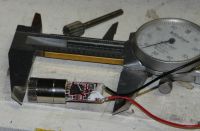
EDIT: i have removed half the wheight by means of cutting off the copper, but a thought occurs : that copper was the heatsink! DAM!
Patrick, Mon Jan 14 2013, 01:32AM
ok new work completed...
ive got two line generating lasers, one will be kep as a backup, in case i kill the other.
for 12 US$ i have a small barrel sized IR laser. I cut the case open to learn its made out of nickel-plated copper, which explians why its too dam heavy. having hack-sawed the case open ive found the back 80% of the tube filled with a dense populated circuit board, so thats a relief. the driver is fully integrated and working.
i wish i could figure out a way to rotate the beam and view port with out rotationg the sensor and laser, since moving brush contacts strike me as unreliable.



EDIT: i have removed half the wheight by means of cutting off the copper, but a thought occurs : that copper was the heatsink! DAM!
Re: Structured Light Experiments (LiDAR Attempt).
iliasam, Wed Jan 16 2013, 01:56PM

But I think that this scheme is not suitable for triangulation lidar.
Hokuyo lidar seems to have brush contacts: http://www.iheartrobotics.com/2010/03/under-hood-secrets-of-hokuyo-urg-04lx.html
Heato lidar have brush contacts.
Also i'm thinking that only brush contacts can give 360 scanning angle.
I have found this contact brush, it is looking interesting: http://www.adafruit.com/products/736
iliasam, Wed Jan 16 2013, 01:56PM
i wish i could figure out a way to rotate the beam and view port with out rotationg the sensor and laser, since moving brush contacts strike me as unreliable.As far as I know, SICK lidar have a special scanning mirror:

But I think that this scheme is not suitable for triangulation lidar.
Hokuyo lidar seems to have brush contacts: http://www.iheartrobotics.com/2010/03/under-hood-secrets-of-hokuyo-urg-04lx.html
Heato lidar have brush contacts.
Also i'm thinking that only brush contacts can give 360 scanning angle.
I have found this contact brush, it is looking interesting: http://www.adafruit.com/products/736
that copper was the heatsink!I think that if your laser's power less then 5mw, laser and it's driver does not need heatsink.
Re: Structured Light Experiments (LiDAR Attempt).
Patrick, Wed Jan 16 2013, 06:32PM
yeah im already looking at carbon/graphite brushes, the geometry of a rotating viewport doesnt seem compatible with our trigonometry. i may start to etch boards soon.
Patrick, Wed Jan 16 2013, 06:32PM
yeah im already looking at carbon/graphite brushes, the geometry of a rotating viewport doesnt seem compatible with our trigonometry. i may start to etch boards soon.
Re: Structured Light Experiments (LiDAR Attempt).
Carbon_Rod, Thu Jan 17 2013, 08:56AM
...still standing firm like the Oak?

Have you considered blinking the laser off, and doing image background subtraction to recover your signal line?
Best of luck,
Rod
Carbon_Rod, Thu Jan 17 2013, 08:56AM
...still standing firm like the Oak?

Have you considered blinking the laser off, and doing image background subtraction to recover your signal line?
Best of luck,
Rod
Re: Structured Light Experiments (LiDAR Attempt).
Patrick, Thu Jan 17 2013, 09:21PM
Patrick, Thu Jan 17 2013, 09:21PM
Carbon_Rod wrote ...
...still standing firm like the Oak?

Have you considered blinking the laser off, and doing image background subtraction to recover your signal line?
Best of luck,
Rod
yes i am already implementing the blink rate into my design, and the DLIS-2k is compatible with image subtraction at high speed....still standing firm like the Oak?

Have you considered blinking the laser off, and doing image background subtraction to recover your signal line?
Best of luck,
Rod
Re: Structured Light Experiments (LiDAR Attempt).
iliasam, Sat Mar 30 2013, 09:25AM
How is the project going?
iliasam, Sat Mar 30 2013, 09:25AM
How is the project going?
Re: Structured Light Experiments (LiDAR Attempt).
Patrick, Sat Apr 06 2013, 04:33PM
im making progress with the BiCopter, ive got it flying level for the first time, im also wanting to buy at least one floor bot Lidar, and i plan to start etching a board soon for the DLIS-2k.
and how is your going? which optical component are you using? i may switch to a cheaper one for initial testing...
Thank you, for asking.
Patrick, Sat Apr 06 2013, 04:33PM
im making progress with the BiCopter, ive got it flying level for the first time, im also wanting to buy at least one floor bot Lidar, and i plan to start etching a board soon for the DLIS-2k.
and how is your going? which optical component are you using? i may switch to a cheaper one for initial testing...
Thank you, for asking.
Re: Structured Light Experiments (LiDAR Attempt).
iliasam, Tue Apr 09 2013, 07:55PM
My lidar project is temporally stopped now. I decided to make another lidar with simplified and more strong mechanics and with iC-LF1401 sensor (it's also has 128 pixels, but it has better sensitivity). iC-LF1401 sensor is easy to buy, so I want to create simple DIY lidar. Now I'm waiting some parts for it.
I refused of using ELIS-1024 sensor, because it has too big analog bandwidth. DLIS-2k is very difficult to buy, I have information then one sensor cost more then 45$ and the minimal order quantity is 10 pieces.
About optics:
Now I'm going to try simple objective from small security camera - like this one: link
In fact it's not very good for iC-LF1401 sensor, but I hope that it would be suitable enough.
iliasam, Tue Apr 09 2013, 07:55PM
My lidar project is temporally stopped now. I decided to make another lidar with simplified and more strong mechanics and with iC-LF1401 sensor (it's also has 128 pixels, but it has better sensitivity). iC-LF1401 sensor is easy to buy, so I want to create simple DIY lidar. Now I'm waiting some parts for it.
I refused of using ELIS-1024 sensor, because it has too big analog bandwidth. DLIS-2k is very difficult to buy, I have information then one sensor cost more then 45$ and the minimal order quantity is 10 pieces.
About optics:
Now I'm going to try simple objective from small security camera - like this one: link
In fact it's not very good for iC-LF1401 sensor, but I hope that it would be suitable enough.
Re: Structured Light Experiments (LiDAR Attempt).
Patrick, Thu Apr 25 2013, 09:10AM
Patrick, Thu Apr 25 2013, 09:10AM
iliasam wrote ...
My lidar project is temporally stopped now. I decided to make another lidar with simplified and more strong mechanics and with iC-LF1401 sensor (it's also has 128 pixels, but it has better sensitivity). iC-LF1401 sensor is easy to buy, so I want to create simple DIY lidar. Now I'm waiting some parts for it.
I refused of using ELIS-1024 sensor, because it has too big analog bandwidth. DLIS-2k is very difficult to buy, I have information then one sensor cost more then 45$ and the minimal order quantity is 10 pieces.
About optics:
Now I'm going to try simple objective from small security camera - like this one: link
In fact it's not very good for iC-LF1401 sensor, but I hope that it would be suitable enough.
if the sensors are slow or expensive, i dont now what we will be able to do! we need to talk about optics too, i was hoping to use simple optics, like a single lens...My lidar project is temporally stopped now. I decided to make another lidar with simplified and more strong mechanics and with iC-LF1401 sensor (it's also has 128 pixels, but it has better sensitivity). iC-LF1401 sensor is easy to buy, so I want to create simple DIY lidar. Now I'm waiting some parts for it.
I refused of using ELIS-1024 sensor, because it has too big analog bandwidth. DLIS-2k is very difficult to buy, I have information then one sensor cost more then 45$ and the minimal order quantity is 10 pieces.
About optics:
Now I'm going to try simple objective from small security camera - like this one: link
In fact it's not very good for iC-LF1401 sensor, but I hope that it would be suitable enough.
Re: Structured Light Experiments (LiDAR Attempt).
iliasam, Mon May 27 2013, 10:27AM
Have you seen this project: ?
?
They have already done a prototype with good characteristics and want to start production.
The only question is the price - they did not give it.
iliasam, Mon May 27 2013, 10:27AM
Have you seen this project:
 ?
?They have already done a prototype with good characteristics and want to start production.
The only question is the price - they did not give it.
Re: Structured Light Experiments (LiDAR Attempt).
radhoo, Mon Jun 03 2013, 08:13AM
How are you progressing?
radhoo, Mon Jun 03 2013, 08:13AM
How are you progressing?
Re: Structured Light Experiments (LiDAR Attempt).
Patrick, Mon Jun 03 2013, 07:44PM
Patrick, Mon Jun 03 2013, 07:44PM
radhoo wrote ...
How are you progressing?
I now posses two XV-11 LiDARs, and will use these in the competition in this august, I will continue to build a superior device for use (hopefully) in august 2014's competition.How are you progressing?
Re: Structured Light Experiments (LiDAR Attempt).
radhoo, Tue Jun 04 2013, 11:48AM
I was hoping you'll be building one from scratch
radhoo, Tue Jun 04 2013, 11:48AM
I was hoping you'll be building one from scratch
Re: Structured Light Experiments (LiDAR Attempt).
Patrick, Tue Jun 04 2013, 04:54PM
Patrick, Tue Jun 04 2013, 04:54PM
radhoo wrote ...
I was hoping you'll be building one from scratch
yes I will have too sometime after august 2013, maybe early 2014. I think ill need greater capability than the XV-11 can provide sooner than I first projected.I was hoping you'll be building one from scratch
Re: Structured Light Experiments (LiDAR Attempt).
Linas, Fri Jun 07 2013, 05:24PM
hey, does any one know fast linear photo-diode sensor ?
128 or 65 points, with 8-20MHz readout CLK.
for now i use TSL1401, and i get 58KHz read speed with FFT, but i need to be able to get 100-200kHz cycle speed.
Best what i was able to find is this:


But i can't get, can't buy, or get samples
and fastest for 128 pixels would be CCD , but it will be expensive to drive (ultrafast multiplexing opamp for single adc readout, and CMOS to MOS logic level convertion is tricky (3.3 to 12V at 10MHz)


Linas, Fri Jun 07 2013, 05:24PM
hey, does any one know fast linear photo-diode sensor ?
128 or 65 points, with 8-20MHz readout CLK.
for now i use TSL1401, and i get 58KHz read speed with FFT, but i need to be able to get 100-200kHz cycle speed.
Best what i was able to find is this:


But i can't get, can't buy, or get samples

and fastest for 128 pixels would be CCD , but it will be expensive to drive (ultrafast multiplexing opamp for single adc readout, and CMOS to MOS logic level convertion is tricky (3.3 to 12V at 10MHz)


Re: Structured Light Experiments (LiDAR Attempt).
Patrick, Fri Jun 07 2013, 07:13PM
DSLI-2k is best, like in the XV-11, but its 45 US$ per chip.
Patrick, Fri Jun 07 2013, 07:13PM
DSLI-2k is best, like in the XV-11, but its 45 US$ per chip.
Re: Structured Light Experiments (LiDAR Attempt).
Linas, Fri Jun 07 2013, 08:55PM
I need to get cycle speed of all PID loop between 100-200KHz (TSL1401 will do 62.5kHz)
Linas, Fri Jun 07 2013, 08:55PM
Patrick wrote ...
DSLI-2k is best, like in the XV-11, but its 45 US$ per chip.
maybe the best, but what about cycle read speed ?DSLI-2k is best, like in the XV-11, but its 45 US$ per chip.
I need to get cycle speed of all PID loop between 100-200KHz (TSL1401 will do 62.5kHz)
Re: Structured Light Experiments (LiDAR Attempt).
Patrick, Sat Jun 08 2013, 09:40PM
5 uS is pretty fast, its definately the sensor aquisistion that will be the slowest part.
Patrick, Sat Jun 08 2013, 09:40PM
5 uS is pretty fast, its definately the sensor aquisistion that will be the slowest part.
Re: Structured Light Experiments (LiDAR Attempt).
Linas, Sat Jun 08 2013, 10:22PM
Linas, Sat Jun 08 2013, 10:22PM
Patrick wrote ...
5 uS is pretty fast, its definately the sensor aquisistion that will be the slowest part.
yes, that's why i need fast clk, maybe 2-phase readout, with 64-128 pixels, and no processing inside chip. i will have shark dsp running 400MHz to do that, coupled with 10-100MSps 16b adc5 uS is pretty fast, its definately the sensor aquisistion that will be the slowest part.
Re: Structured Light Experiments (LiDAR Attempt).
Patrick, Sun Jun 09 2013, 12:20AM
and yes, as youve concluded, reducing the pixel count may be the only way to really pour on the speed. you may need to parallel the low-count pixel sensors, each sensor with a channel A/D and MCU channel, to meet your needs of bandwidth.
Patrick, Sun Jun 09 2013, 12:20AM
Linas wrote ...
just out of curiosity, what is it your doing that needs such speed? Patrick wrote ...
5 uS is pretty fast, its definately the sensor aquisistion that will be the slowest part.
yes, that's why i need fast clk, maybe 2-phase readout, with 64-128 pixels, and no processing inside chip. i will have shark dsp running 400MHz to do that, coupled with 10-100MSps 16b adc5 uS is pretty fast, its definately the sensor aquisistion that will be the slowest part.
and yes, as youve concluded, reducing the pixel count may be the only way to really pour on the speed. you may need to parallel the low-count pixel sensors, each sensor with a channel A/D and MCU channel, to meet your needs of bandwidth.
Re: Structured Light Experiments (LiDAR Attempt).
Linas, Sun Jun 09 2013, 07:02AM
Linas, Sun Jun 09 2013, 07:02AM
Patrick wrote ...
just out of curiosity, what is it your doing that needs such speed?
I am working on +-ultrafast spectroscopy,just out of curiosity, what is it your doing that needs such speed?
Re: Structured Light Experiments (LiDAR Attempt).
iliasam, Sun Jun 09 2013, 01:00PM
What about iC-LF1401? The maximum pixel readout frequency is 5MHz. It's 2.5 times faster than TSL1401.
iliasam, Sun Jun 09 2013, 01:00PM
What about iC-LF1401? The maximum pixel readout frequency is 5MHz. It's 2.5 times faster than TSL1401.
Re: Structured Light Experiments (LiDAR Attempt).
Linas, Sun Jun 09 2013, 01:05PM
Hm, i don't think so
TSL1401CL:
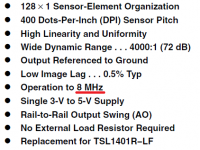
Oh, i get myself again, as it turns out, i can't find any RL0256EEQ-011 Datasheet ( I had for D, not E series),

Any idea how to get it ? i try to contact PerkinElmer but with no result ...
Linas, Sun Jun 09 2013, 01:05PM
iliasam wrote ...
What about iC-LF1401? The maximum pixel readout frequency is 5MHz. It's 2.5 times faster than TSL1401.
What about iC-LF1401? The maximum pixel readout frequency is 5MHz. It's 2.5 times faster than TSL1401.
Hm, i don't think so
TSL1401CL:

Oh, i get myself again, as it turns out, i can't find any RL0256EEQ-011 Datasheet ( I had for D, not E series),


Any idea how to get it ? i try to contact PerkinElmer but with no result ...

Re: Structured Light Experiments (LiDAR Attempt).
Patrick, Sun Jun 16 2013, 04:43AM
a well said statement (as pertaining to the XV-11 LiDAR ):
In response to a question, as to what LiDAR really "is"...
[Source:
Patrick, Sun Jun 16 2013, 04:43AM
a well said statement (as pertaining to the XV-11 LiDAR ):
In response to a question, as to what LiDAR really "is"...
[Source:

by chrlsrchrdsn - 12/10/2010 - 11:36pm
Either ToF or Triangulation are LIDAR. The concept is to shoot a specific beam of light from a laser (though technically you don't have use a laser, you could use something like a pinhole focused LED, but the range would be very short) then use the return from that specific beam to generate the results. Time of Flight is most commonly used until now because high speed CMOS sensors were not available in the 1990s. However precise clocks and a sensor that could tell it got hit fast enough was. After a bit, instead of using a clock you could actually read the charge level of the recharging laser pulse capacitor at the time the sensor said it was hit and give a distance reading since moving electrons and light aren't too far off in speed.
BUT now CMOS sensor of sufficient speed and with global shutter make triangulation possible. (Global shutter is a way to "gate" the picture by recording all pixels simultaneously. No having to read in the lines to get the results that could be changing as you read.) Triangulation is less sensitive to beam scatter than ToF, and triangulation can actually be more accurate for sub-mm measurement.
Okay, the simple answer, triangulation is a recognized medthod for LIght Detection And Ranging.
Login or register to post comments
Print this page
